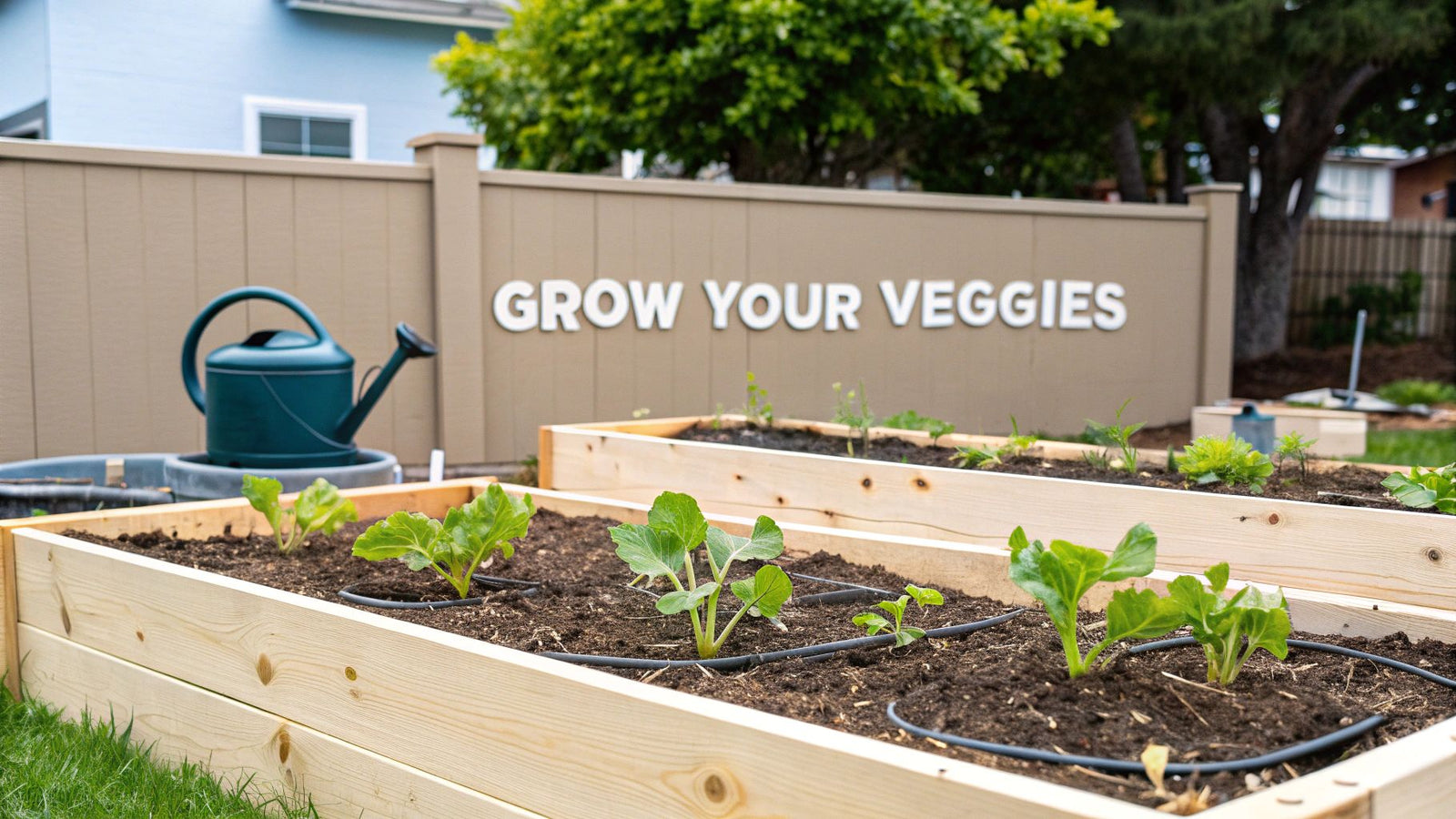
Starting a vegetable garden is one of the most rewarding things you can do. It's about more than just growing food; it’s about transforming a little patch of your world into a source of fresh, delicious produce. I've found the whole process breaks down into four main parts: figuring out your space, getting the soil just right, planting your veggies, and then keeping them happy. Once you get the hang of these, gardening becomes less of a chore and more of a joy.
Your Journey to a Thriving First Garden
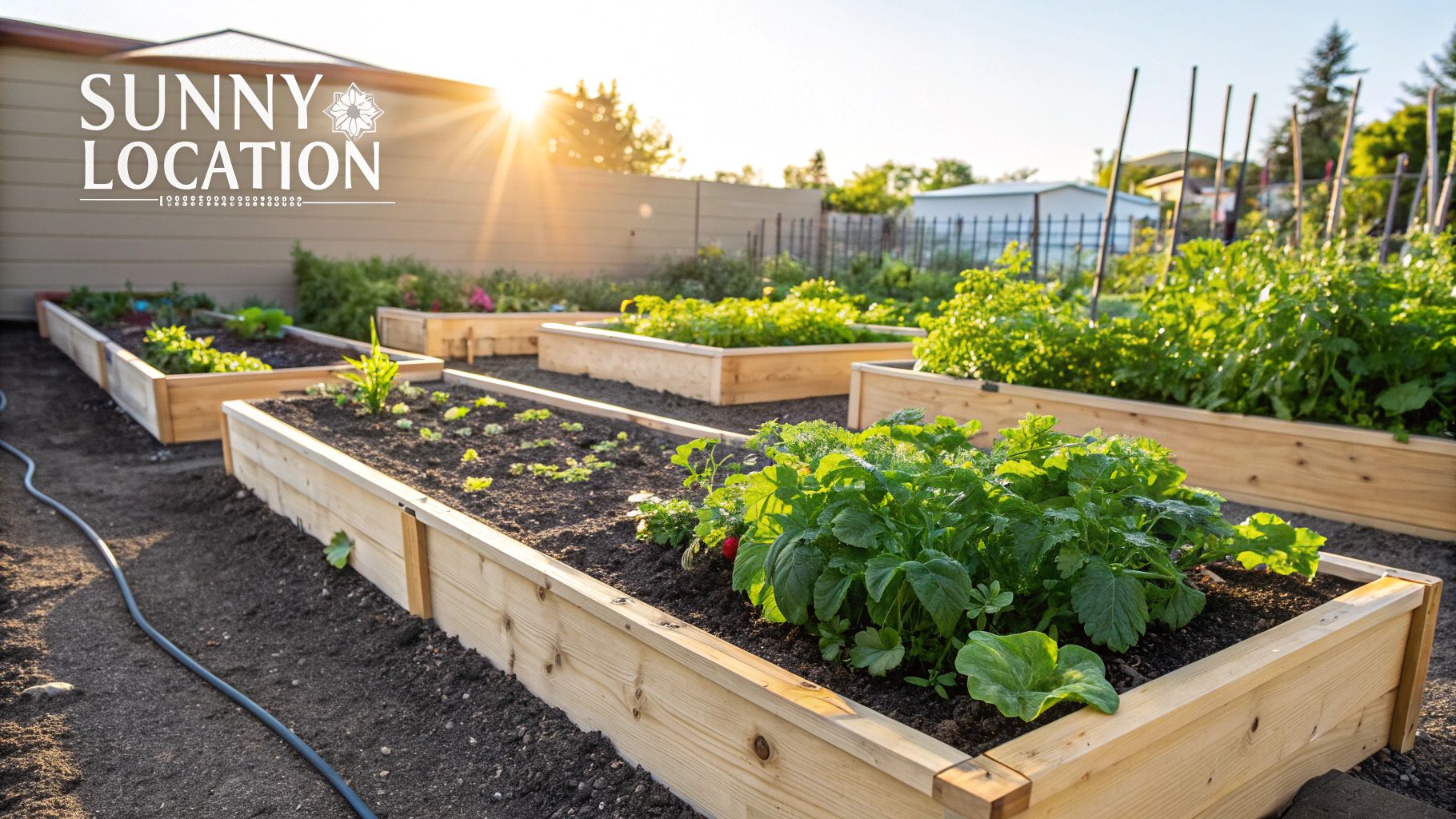
Welcome to the wonderful world of growing your own food! This isn't just about sticking seeds in the dirt and hoping for the best. It's about understanding the simple magic behind it all. There’s a special kind of pride that comes from picking something you grew yourself, and trust me, the taste of a tomato still warm from the sun is something you’ll never find in a grocery store.
On top of the amazing flavors, gardening is a great way to get outside, move your body, and connect with nature. It can even trim a little off your food budget. Think of this guide as your personal roadmap. We'll walk through everything together, making the path from bare ground to a plate full of fresh vegetables feel easy and exciting.
And you're in good company! Gardening is more popular than ever. In fact, a recent report I read showed that about 55.9% of gardeners are planning to make their gardens even bigger this year. This excitement, especially from younger folks, really shows how much people value the benefits for both mind and body. You can dive deeper into what's new in the gardening world by checking out the latest trends from Petrus Landscape.
A High-Level View of the Process
To give you a clearer picture of what's ahead, let’s quickly look at the big steps. To make it even easier, here's a simple table that breaks down the whole process.
Your First Vegetable Garden at a Glance
| Phase | Key Action | Beginner's Focus |
|---|---|---|
| Planning | Choosing your spot & size | Find 6-8 hours of daily sun; start with a 4x4 foot bed or large pots. |
| Preparing | Amending the soil | Mix in plenty of compost to create rich, fertile ground for your plants. |
| Planting | Sowing seeds or starts | Pick easy-growers like lettuce, radishes, or zucchini. Follow spacing rules. |
| Nurturing | Watering, weeding, watching | Water consistently, pull weeds weekly, and keep an eye out for common pests. |
Seeing it laid out like this helps make it feel much more manageable, right? Each phase logically flows into the next, building a solid foundation for a great harvest.
Let's unpack those phases a bit more.
-
Planning: This is where you play strategist. You'll pick the sunniest spot in your yard, decide if you want to plant in the ground or use containers, and choose a size that feels doable, not daunting.
-
Preparing: Great gardens start with great soil. This step is all about making your soil a five-star hotel for your plant roots by adding organic goodness like compost.
-
Planting: Now for the fun part! You'll choose some beginner-friendly vegetables, decide whether to start from seeds or buy small plants (called starts), and get them into the ground.
-
Nurturing: This is the day-to-day care. It’s all about consistent watering, keeping the weeds at bay so they don’t steal nutrients, and watching for any little critters who want to share your harvest.
My best advice for any new gardener? Start small. A simple 4x4 foot raised bed or even just a few big pots is plenty for your first season. You'll get a great harvest without feeling overwhelmed, which is key to enjoying the experience.
By tackling your first garden with this structured approach, you're not just setting yourself up for a basket of fresh vegetables. You're building confidence and, hopefully, starting a hobby you'll love for years to come.
Finding the Perfect Home for Your Garden
Before you buy a single seed packet or bag of soil, the most critical decision you'll make is where your garden will live. This one choice can be the difference between a basket full of fresh tomatoes and a season of disappointment. It really is the classic real estate mantra: location, location, location.
The absolute, most important rule of thumb is sunlight. Most vegetables are total sun lovers, needing at least 6-8 hours of direct, unfiltered sun every single day. Plants that produce a fruit—think tomatoes, peppers, squash, and cucumbers—are especially hungry for light. Skimp on this, and you'll end up with spindly, weak plants and a very sad harvest.
Become a Sunshine Detective
To find your yard's sweet spot, you need to do a little reconnaissance. Spend a day watching how the sun moves across your property. Where is it in the morning? At noon? In the late afternoon? Don't just guess. Take notes. A south-facing location is usually a safe bet, but any spot that consistently clocks in with that 6-8 hour minimum is a winner. A bit of observation now saves a world of frustration later.
Next up: water. You’ll be watering your garden a lot, especially in the heat of summer. Trust me when I say that hauling heavy watering cans from the other side of the yard gets old really fast. Do yourself a huge favor and pick a spot that’s close to a hose or outdoor spigot. It’s a simple choice that will make your daily gardening chores so much more pleasant.
Finally, consider the lay of the land. Avoid low spots where water collects after a heavy rain; soggy roots lead to rot, which is a quick way to kill a plant. You’ll also want to steer clear of natural wind tunnels that can batter your tender seedlings and dry them out in a hurry. You’re looking for a spot that’s sunny, relatively level, and has some protection from the elements.
What Kind of Garden Is Right for You?
Once you’ve found that perfect sun-drenched, easy-to-water spot, it's time to decide on the type of garden you'll build. This decision often comes down to your space, budget, and how much work you want to put in upfront. For a first-timer, there are three fantastic options.
Traditional In-Ground Garden
This is the classic approach: tilling up a patch of your lawn and planting directly in the earth. It's the most budget-friendly way to get started, especially if you've been blessed with decent soil.
- The good: It's cheap to set up, gives roots plenty of room to roam, and looks beautifully integrated into your landscape.
- The bad: It can be a ton of back-breaking work to remove the sod and prepare the soil. You'll also be in a constant battle with weeds, and all that bending over can be tough on the body.
Raised Garden Beds
These are essentially bottomless boxes you place right on the ground and fill with a perfect soil mix. There's a reason they're so wildly popular with new and experienced gardeners alike.
- The good: You get perfect drainage, way fewer weeds, and complete control over the soil quality right from the start. The soil also warms up faster in the spring, giving your plants a head start.
- The bad: There's a higher upfront cost for lumber and all that bagged soil. They also tend to dry out more quickly than in-ground beds, so you'll need to stay on top of watering.
Container Gardening
Don't have a yard? No problem. If you have a sunny balcony, deck, or patio, you can grow an amazing amount of food in containers.
- The good: It’s the ultimate solution for small spaces. The pots are portable, and you have total control over the soil and watering for each individual plant.
- The bad: Pots dry out incredibly fast—often needing water every single day in hot weather. You also have to make sure your containers are big enough, or your plants' roots will get cramped and stunted.
For anyone just starting out, I almost always recommend building a raised bed or starting with a few large containers. They take the biggest unknown—your native soil quality—out of the equation and provide a clean, defined space to learn the ropes.
Start Small, Win Big
I've seen it a hundred times: the over-enthusiastic beginner who tills up a massive 20x20 foot plot, only to have it become an overwhelming jungle of weeds by July. Your goal in year one is to learn, have fun, and actually eat what you grow—not to feed the entire block.
A 4x4 foot or 4x8 foot raised bed is the perfect starting point. It’s big enough to grow a surprising variety of vegetables but small enough that weeding, watering, and harvesting feel like a joy, not a chore. By starting small, you set yourself up for a successful first season, which is the best way to make sure you’ll be gardening for years to come.
Building Rich Soil for Healthy Plants
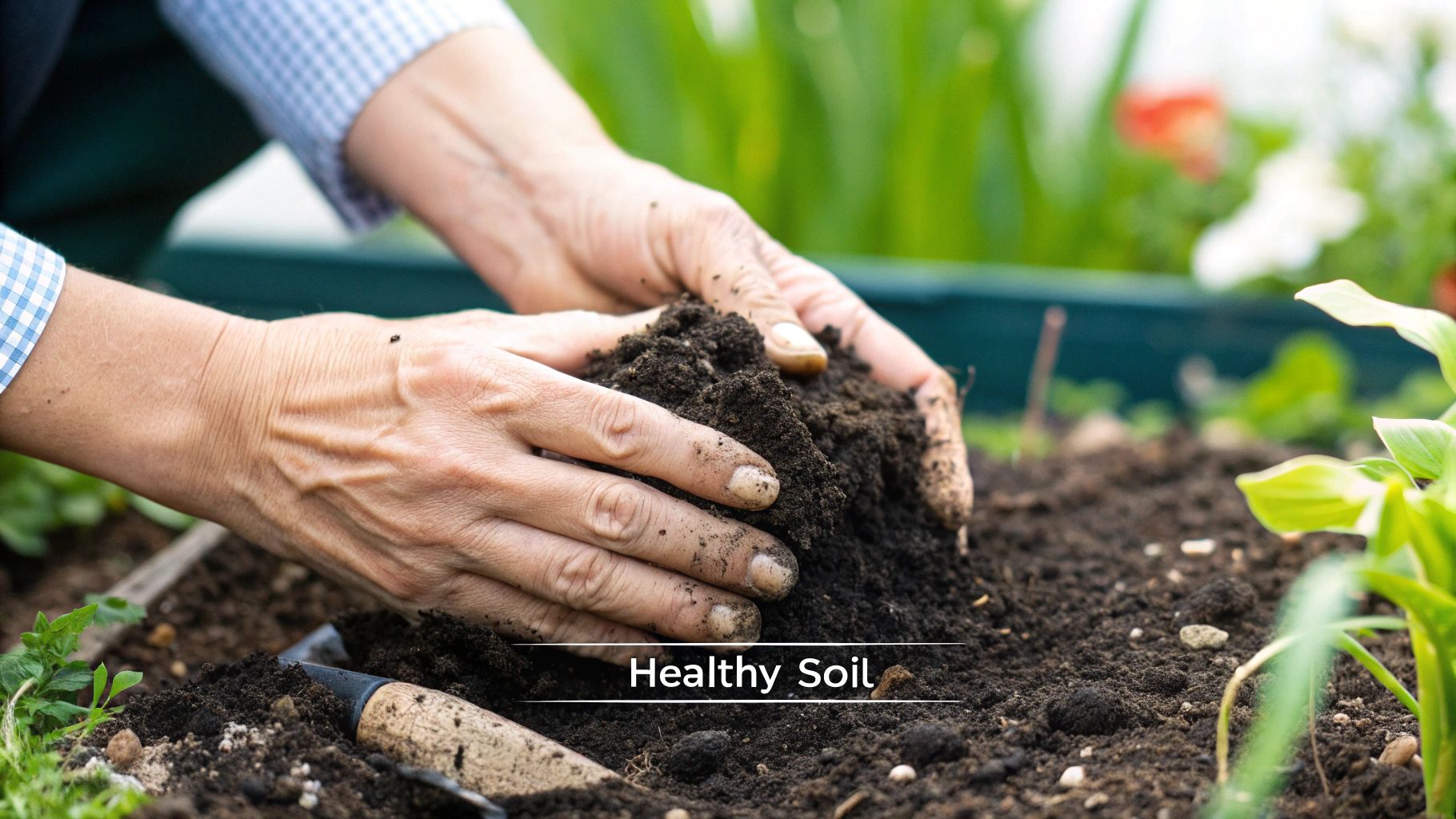
If there’s one secret to a bountiful vegetable garden, it’s this: it all starts with the soil. You can pick the perfect plants and have the sunniest spot in the yard, but if your soil is poor, your garden will struggle.
Think of your garden soil as the foundation of a house. When it’s rich, stable, and full of life, your plants have everything they need to grow strong and produce delicious vegetables. Your mission, especially as a beginner, is to create soil that’s dark, crumbly, and alive.
Know What You're Working With
Before you start adding things to your soil, it’s a good idea to get a feel for what you have. Most garden soil falls into one of three main categories, and each one has its own distinct personality.
- Clay Soil: Heavy, dense, and sticky when wet. When it dries, it can turn into a brick-like slab. While it holds onto nutrients well, its poor drainage can be a real problem, often leading to root rot.
- Sandy Soil: The complete opposite of clay. It feels gritty, drains incredibly fast, and struggles to hold onto water and nutrients. Plants in sandy soil can get thirsty and hungry very quickly.
- Loam: This is the gardener’s dream. Loam is a beautiful, balanced mix of sand, clay, and organic material. It's dark, crumbly, and holds just the right amount of moisture.
Don't worry if your soil isn't perfect loam. Very few are. The great news is that no matter what you’re starting with, the solution is almost always the same: add more organic matter. It's the universal fix. For a deeper dive into figuring out your soil type, check out our guide on preparing garden soil.
The Magic of Organic Matter
So, what is this "organic matter" I keep mentioning? It’s simply decomposed material from plants and animals, and it’s the single most important ingredient for healthy garden soil. It works wonders on every soil type, improving drainage in clay and water retention in sand.
My Go-To Soil Amendments:
- Compost: This is the absolute gold standard. Good compost adds a slow, steady supply of nutrients and introduces a whole ecosystem of beneficial microbes. Whether you make your own or buy it by the bag, compost is non-negotiable for a truly thriving garden.
- Aged Manure: Sourced from animals like chickens, cows, or horses, manure is a fantastic nitrogen boost. The key word here is "aged." Fresh manure is far too "hot" (high in nitrogen) and will burn your plants' delicate roots.
- Leaf Mold: This is just a fancy term for decomposed leaves. It's an incredible soil conditioner, especially for improving water retention. If you have sandy soil, this stuff is your best friend.
Adding these amendments builds what gardeners call the "soil food web," an underground ecosystem that's vital for healthy plants. It’s no surprise that as more people seek produce free from synthetic chemicals, the demand for organic gardening supplies is on the rise. In fact, major seed companies are now introducing organic lines for popular vegetables across North America and Europe to meet this growing interest. You can learn more about these market trends from Business Wire.
Try a No-Dig Approach
If the thought of double-digging a garden bed makes your back hurt, I have great news. The "no-dig" or "no-till" method is a fantastic, low-effort approach that's perfect for beginners. Instead of turning over the soil, you simply build it up by layering organic matter on top.
Here’s how you can get started with a no-dig bed:
- First, lay down a layer of cardboard right over the grass or ground where you want your garden. This acts as a natural weed barrier.
- Give the cardboard a good soaking with a hose to kickstart the decomposition process.
- Now, pile on a thick layer—at least 4 to 6 inches—of compost and any other organic goodies you have.
- That's it! You can plant directly into that beautiful top layer of compost.
This technique protects the delicate fungal and microbial networks in the soil, keeps the worms happy, and drastically cuts down on weeds. You’re essentially mimicking how nature builds fertile soil in a forest, feeding it from the top down. The result is an incredibly healthy and low-maintenance garden.
Selecting and Planting Your First Vegetables
Alright, this is the exciting part—deciding what you’ll actually grow! This is where the vision for your garden really begins to take shape. The secret to a successful and rewarding first season is to pick vegetables that are pretty forgiving. You want to set yourself up for an early win; it’s the best motivation there is.
Think of your first plants like easygoing friends. They don’t demand much but give you a lot in return. Building your first garden with these kinds of reliable veggies will boost your confidence and, more importantly, fill your kitchen with fresh food.
Your First Garden All-Stars
For your first go-around, focus on plants known for being tough and productive. Some vegetables are just plain easier to grow from seed, can handle less-than-perfect conditions, and give you a harvest pretty quickly. That fast turnaround is incredibly encouraging for a new gardener.
To get you started, here's a quick rundown of some can't-miss choices for a beginner's plot.
Top 10 Easiest Vegetables for Your First Garden
To make things even easier, I've put together a simple chart with some of the most reliable vegetables for beginners. It gives you a quick snapshot of when to plant them, how much sun they need, and about how long you'll have to wait before you can start harvesting.
| Vegetable | Best Time to Plant | Sunlight Needs | Days to Harvest (Approx.) |
|---|---|---|---|
| Bush Beans | Late Spring | 6-8 hours | 50-60 days |
| Leaf Lettuce | Early Spring / Fall | 4-6 hours | 45-55 days |
| Radishes | Early Spring / Fall | 4-6 hours | 25-35 days |
| Zucchini | Late Spring | 6-8 hours | 45-60 days |
| Cherry Tomatoes | Late Spring | 8+ hours | 60-70 days |
| Peas | Early Spring | 6-8 hours | 60-70 days |
| Carrots | Early Spring / Fall | 6-8 hours | 60-80 days |
| Spinach | Early Spring / Fall | 4-6 hours | 40-50 days |
| Cucumbers (Bush) | Late Spring | 6-8 hours | 55-65 days |
| Kale | Early Spring / Fall | 6+ hours | 55-75 days |
Choosing any of these is a great first step. They’re popular for a reason—they deliver great results without a ton of fuss, making them perfect for building your gardening skills.
Seeds or Seedlings: What's the Better Bet?
Next up, you need to decide if you're starting from scratch with seeds or getting a head start with young plants, often called seedlings or transplants. Honestly, there are good reasons for both, and your choice might depend on the plant itself and how patient you're feeling.
Starting with seeds is definitely the most budget-friendly route. A packet of seeds costs just a few bucks and can give you dozens of plants. Plus, there's something truly magical about watching a tiny seed sprout and grow into a food-producing machine. This is the way to go for fast-growing veggies like radishes, beans, carrots, and lettuce.
On the flip side, buying seedlings from a local nursery gives you a serious jump on the season. A professional has already done the tricky work of getting them through their fragile baby stage. This is a brilliant move for plants that take a long time to mature, like tomatoes, peppers, and eggplant, since it can shave weeks or even months off your wait time for a harvest.
For a first-timer, I always suggest a mix-and-match strategy. Start your quick-growing crops like beans, peas, and radishes directly from seed in the garden. Then, spend a little extra on healthy-looking seedlings for your long-haul plants like tomatoes and peppers. You really get the best of both worlds.
Getting Your Plants in the Ground
How you plant your vegetables is crucial. One of the biggest mistakes I see beginners make is crowding their plants. They need room to spread their roots and for air to flow between them, which is a simple way to help prevent common fungal diseases.
Your best friend here is the seed packet or the plant tag—think of it as your instruction manual! It will tell you exactly how deep to plant and how much space to leave between each one.
This little visual guide is a handy reference for spacing some common garden veggies.
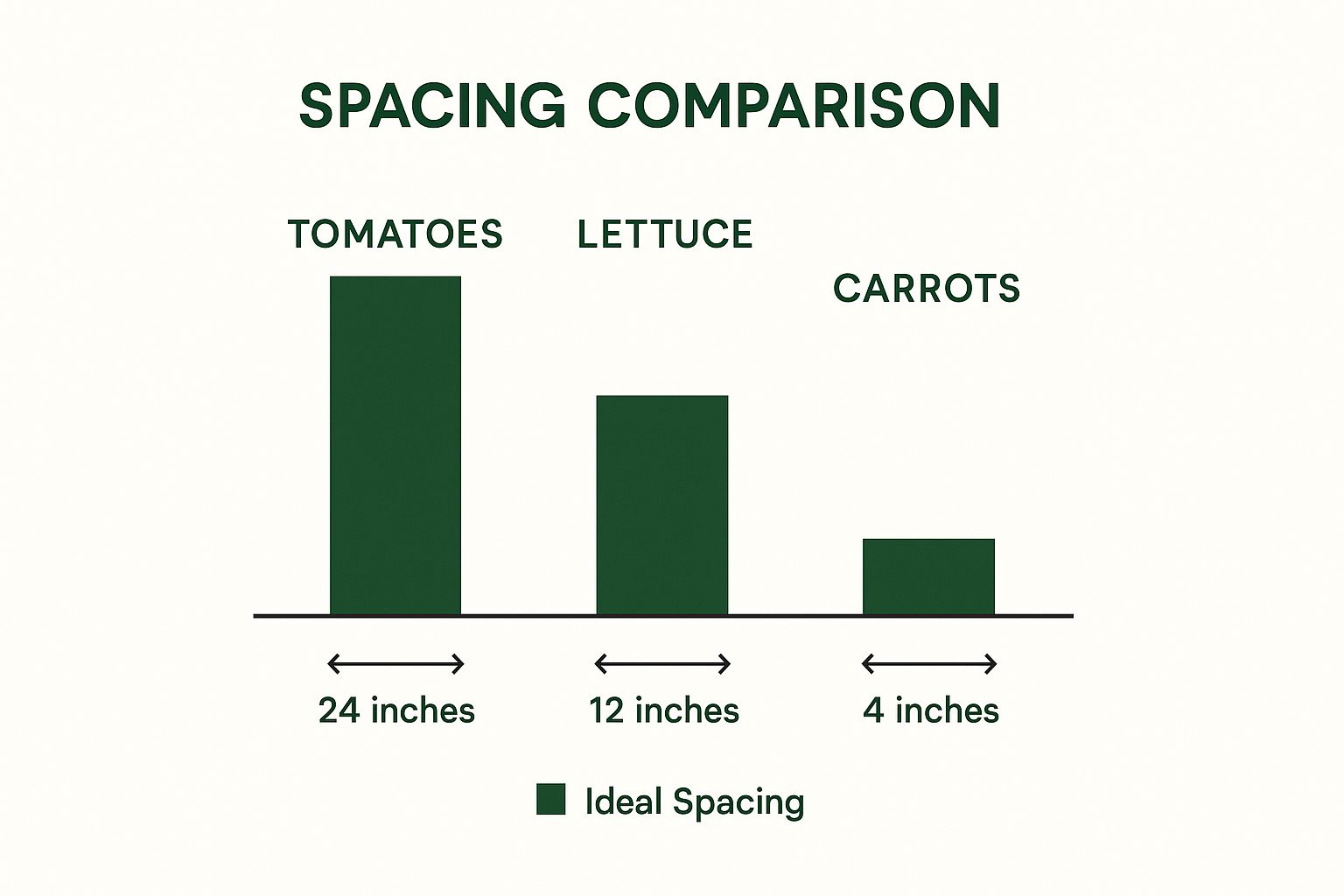
As you can see, a big, sprawling tomato plant needs a lot more personal space than a neat little carrot or a compact head of lettuce. Giving them that room is non-negotiable for a healthy, productive garden.
When you're planting, a good rule of thumb is to sow seeds at a depth about twice their diameter. For seedlings, dig a hole that's a bit bigger than the pot they came in and plant them at the same soil level. Gently pat the soil around their base and give them a good, long drink of water to help them settle into their new home.
The Magic of Companion Planting
Here's a fantastic pro-gardener trick: companion planting. It’s just the simple practice of growing certain plants next to each other because they help each other out. Some combinations can ward off pests, attract good bugs like pollinators, or even make their neighbors taste better.
A classic example is planting basil near your tomatoes. The strong aroma of basil is known to repel pests like tomato hornworms and whiteflies. Another great one is planting marigolds throughout your garden beds to help deter tiny soil pests called nematodes.
If you want to dive deeper, you can explore our guide on which vegetable seeds go well together for more proven garden friendships. It’s a simple, organic way to give your new vegetable garden an extra layer of defense.
Caring for Your Growing Garden
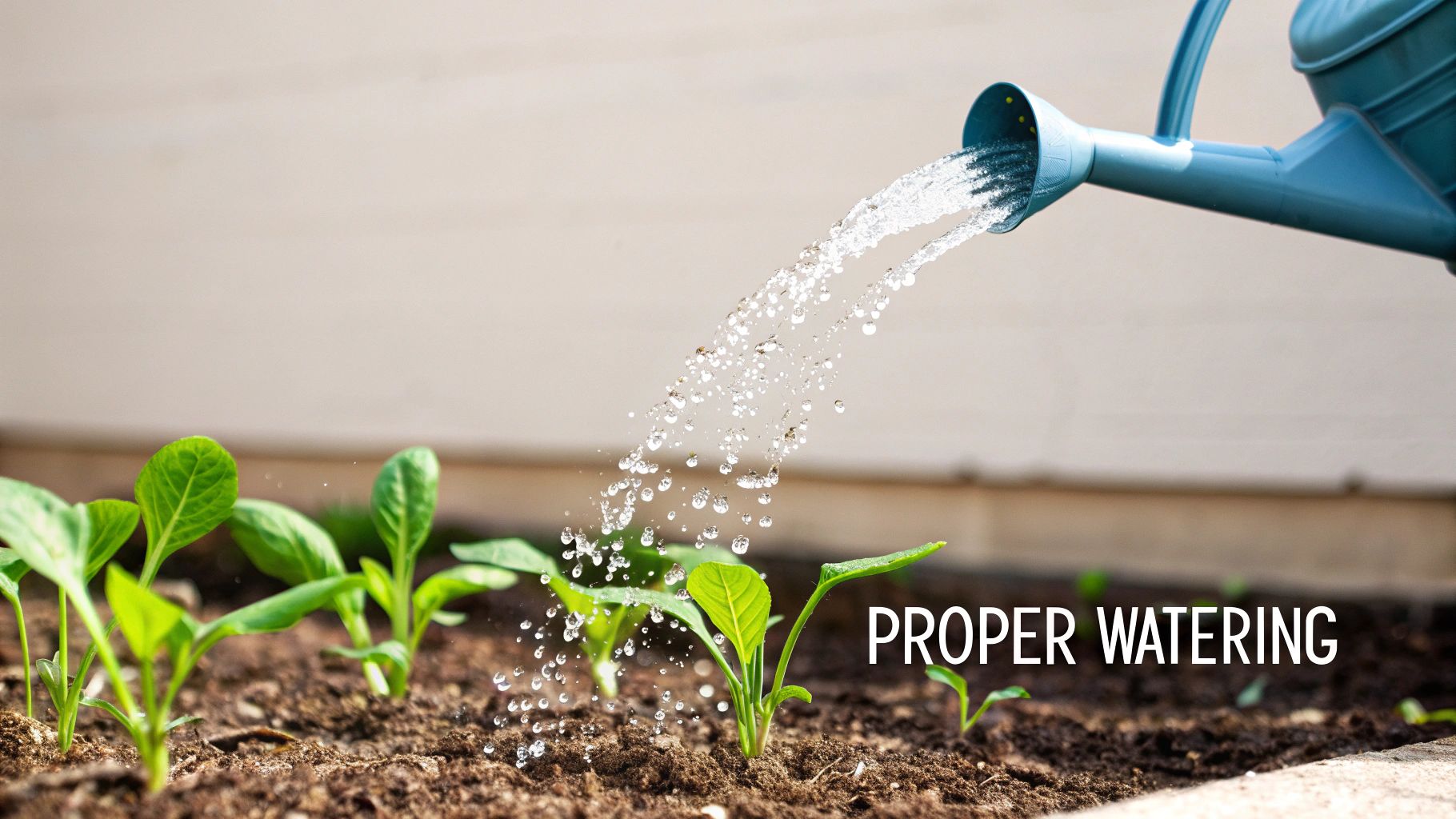
Alright, your plants are in the ground. Now the real fun begins. Your role has officially shifted from garden architect to caretaker, and it's this ongoing attention that coaxes tiny seedlings into a bountiful harvest. Don't think of these daily and weekly tasks as chores. Instead, see them as your chance to really connect with your garden, watch it grow, and learn to respond to what it needs.
Consistent care is what separates a thriving garden from a struggling one. It’s like having a conversation with your plants—they’ll absolutely show you what they need, as long as you know what to look for.
The Art of Watering Your Garden
Watering seems basic, I know, but how and when you do it makes a world of difference for your plants' health. The whole point is to encourage roots to grow deep and strong, not to stay shallow and weak right at the surface.
The easiest way to know if it's time to water is the "finger test." Seriously, it works. Just stick your index finger about an inch down into the soil near your plants. If it feels dry, it’s time to water. Still a bit damp? You can hold off. This simple trick is your best defense against both underwatering and the dreaded root rot from overwatering.
When you do water, aim for a deep, infrequent soak. Giving your garden about one inch of water per week (and yes, that includes any rain you get) in one long, slow session is so much better than a quick daily sprinkle. This method forces the roots to reach down into the soil for moisture, which builds a much more resilient plant that can handle those hot, dry spells later in the summer.
My Go-To Tip: Always water in the morning. This gives the leaves all day to dry out before the sun goes down, which is the single best way to prevent common fungal issues like powdery mildew. Wet leaves at night are an open invitation for disease.
Keeping Weeds Under Control
Weeds are more than just ugly—they're bullies. They compete with your vegetables for water, sunlight, and precious nutrients, and they can seriously cut into your harvest. The secret to winning the war on weeds? Get 'em early and get 'em often.
Spending just 10-15 minutes pulling weeds a couple of times a week feels way less daunting than trying to reclaim a jungle after letting it go for a month. A great tip is to weed after a good rain or watering session; the damp soil lets them slide right out, roots and all.
If you want to be more proactive, mulching is your best friend. A two- to three-inch layer of organic mulch like straw, shredded leaves, or grass clippings is a game-changer.
- It smothers weeds by blocking the sunlight they need to sprout.
- It holds in moisture, which means you water less.
- It regulates soil temperature, keeping roots cooler in the summer and a bit warmer during those cool spring and fall nights.
Dealing with Common Garden Pests
Sooner or later, you'll discover that you're not the only one who finds your vegetables delicious. Don't panic! The trick for a beginner's garden is to manage pests with simple, low-impact methods that don't involve harsh chemicals.
Your first line of defense is simply paying attention. Get in the habit of checking your plants regularly, especially the undersides of leaves where pests love to hide. Catching a problem early makes it a thousand times easier to handle. For bigger culprits like tomato hornworms or squash bugs, the most effective tool is your own two hands. Just pick them off and drop them into a bucket of soapy water.
For smaller pests like aphids, here are a few things to try:
- A strong jet of water from the hose can often be enough to knock them right off your plants.
- Insecticidal soap is a safe, organic option you can buy at any garden center. It works on contact with soft-bodied insects but is gentle on your plants and most beneficial bugs.
- Physical barriers, like lightweight row covers, are fantastic for keeping pests like cabbage moths from ever laying their eggs on your broccoli and kale in the first place.
With food costs being what they are, a home garden makes more sense than ever. The average availability of vegetables per person in the U.S. has dropped to 376 pounds, while at the same time, the vegetable price index jumped 11%. These numbers, which you can dig into deeper via the USDA Economic Research Service, really show how growing your own can provide both fresh food and a nice buffer against rising prices.
By building these simple watering, weeding, and pest control habits into your weekly routine, you’ll be well on your way to a garden you can be proud of. And if you're still deciding what to plant, be sure to check out our guide on the best vegetables to grow for beginners.
Common Beginner Gardening Questions Answered
Before you break ground, you probably have a few questions rolling around in your head. That's a good thing! Getting these common questions answered upfront can save you a lot of guesswork and help you sidestep some of the usual tripwires for new gardeners.
Let’s dive into what most beginners are wondering about.
How Much Does It Really Cost to Start a Vegetable Garden?
This is always a top question, and the honest answer is: it really depends on your approach. The fantastic news is that a vegetable garden doesn't have to break the bank. You can absolutely get a small, productive plot going for as little as $50 to $100.
What does that cover? Usually, that budget will get you the bare essentials: a few bags of quality garden soil or compost, a handful of seed packets, and some basic tools like a trowel and a good pair of gardening gloves. If you choose to buy starter plants (the little seedlings already growing) instead of seeds, your costs will be a bit higher.
The price can climb if you add features like raised beds. A simple pre-made kit can be found for around $50, but a larger, more durable cedar bed might set you back $200 or more. If you're looking to save money, get creative! Making your own compost is a brilliant way to create free, nutrient-packed soil conditioner. You can also turn old buckets or containers into a patio garden—just don't forget to drill drainage holes.
The best part of a vegetable garden is the return on your investment. That initial cost often pays for itself within a season or two, especially when you see the price of fresh produce at the grocery store.
What Are the Most Common Mistakes Beginners Make?
Learning from your own mistakes is part of gardening, but learning from other people's mistakes is a whole lot easier. I've seen new gardeners make the same few errors time and again, and avoiding them will put you on the fast track to a successful harvest.
Here are the top five hurdles to watch out for:
- Starting Too Big: It's easy to get carried away with ambition, but a garden that's too large quickly turns into an overwhelming chore. It's far better to master a small 4x4 foot plot than to give up on a huge, weedy mess.
- Ignoring Sunlight: This one is a deal-breaker. Planting sun-loving veggies like tomatoes and peppers in a shady corner is a recipe for disappointment. Most vegetables need 6-8 hours of direct sun every single day.
- Watering Wrong: Plants get stressed from both too much and too little water. The best way to know when to water is to simply feel the soil. If the top inch is dry, it’s time for a deep, thorough watering at the base of the plant.
- Skipping Soil Prep: You can't just dig a hole in poor, compacted dirt and expect plants to thrive. That’s like asking them to run a marathon with no food or water. Mixing in plenty of compost is the single most important thing you can do to give your garden a healthy foundation.
- Planting at the Wrong Time: Every plant has its season. Tender seedlings planted too early will get wiped out by a late frost. Always check your local planting calendar, which is based on your area's last frost date.
Simply sidestepping these common blunders will dramatically increase your chances of having a garden you can be proud of.
How Do I Know When to Harvest My Vegetables?
Knowing that perfect moment to pick your produce is a skill that you'll develop with experience, but don't worry—there are plenty of signs to look for. Your first and best guide is the seed packet or plant tag. It almost always gives you an estimated "days to harvest" number to work with.
For many plants, harvesting frequently actually signals the plant to produce even more. This is definitely true for crops like bush beans, peas, and zucchini.
Here are a few specific pointers:
- Leafy Greens: With lettuce, kale, and chard, you can use the "cut and come again" method. Just snip off the outer leaves as you need them, and the center of the plant will keep growing new ones for you.
- Tomatoes: Don't just go by size. Wait for them to reach their full, deep color—whether that’s red, yellow, or even purple. They should feel firm to the touch, but with a slight give.
- Zucchini: These are notorious for getting huge overnight. Pick them when they are young and tender for the best flavor and texture. If you let them grow into baseball bats, they become watery and bland.
- Root Vegetables: For carrots, beets, and radishes, you can cheat a little. Gently brush away the soil from the top of the root (its "shoulder") to get a peek at its size. Harvest when it looks big enough to eat.
Do I Need to Fertilize My Vegetable Garden?
This is a great question. If you put in the effort up front and started with rich soil full of good compost, you might not need to fertilize much at all. Compost acts as a slow-release food source that can sustain many plants all season long.
That said, some vegetables are known as "heavy feeders" and will be much happier with an extra nutritional boost, especially in the middle of the growing season. These are typically the plants that produce big fruits, like tomatoes, peppers, squash, and corn.
For a beginner’s garden, sticking with a balanced, organic fertilizer is a great practice. You generally have two choices: a granular fertilizer you can sprinkle around the base of your plants a few weeks after they're in the ground, or a liquid one (like fish emulsion) that you mix with water and apply every 2-4 weeks.
No matter what you use, follow the package instructions carefully. It's surprisingly easy to over-fertilize, which can burn plant roots and cause more harm than good. The best philosophy is to feed the soil first with compost, and then use fertilizer as a targeted supplement only for the plants that really need it.
At Homegrown Garden, we believe everyone can grow their own food. We're here to support your gardening journey with high-quality heirloom seeds, easy-to-use kits, and expert advice. Explore our collections and find everything you need to get started today at https://www.homegrown-garden.com.



